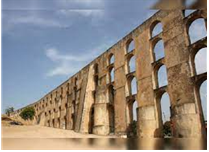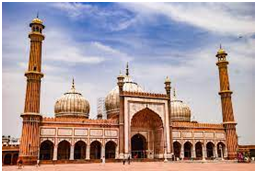- Books Name
- Social Science Book
- Publication
- Cognizance Publication
- Course
- CBSE Class 7
- Subject
- Social Science
Expansion of Sultanate
From Garrison Town to empire, the expansion of the Delhi Sultanate

With the arrival of the Mongols and the Afghan invaders in the period of medieval history started. The invaders like Ghori never wanted to rule India, they just wanted to plunder the richest and use them for their lives in their own land. The period of Delhi Sultanate started in 1206 with the slave dynasty and Ibrahim Lodi became the last of the rulers in 1526.The Delhi Sultanate has been one of the most prominent ruling dynasties of Indian medieval history. Delhi has always been one of the most wanted region because of its central location and excellent connectivity. The popularity of the city grew in the 12th century and it became one of the most predominant centres of trade and culture.The city of Delhi gained popularity in 12th century.Under the tomaras and chauhans it grew as a popular centre of trade and commerce. The commercialization of the city leads to several Jainas moving to Delhi for business. Several Jain temples were constructed during this phase. Soon, Delhi emerged as the capital of Tamara Kingdom, which led to several rulers place in their eyes on the capital.
In the early 13th century, Delhi was just confined to fortified walls.The city heavily banked upon trade and trade was inturn dependent on trade routes. However, the trade routes often closed down due to bad weather.Under the reign of Gyassudin Balaban,the Mongols allmost overpowered the Delhi sultanate.However with Alauddin Khilji and the Muhammad Tughlaq taking over the throne,the Delhi sultanate was strengthened again.The two Kings successfully conquered neighbouring areas and cleared the Ganga, Yamuna doab and hunter gatherers and pastoralists expelled from their habitat.These lands were given to peasants and agriculture was encouraged. New fortresses, garrison town and towns were established to protect trade routes and to promote regional trade.The military frontier of the Delhi Sultanate then waged war against several arch-rivals and managed to win the battles, hence leading to the expansion of Delhi Sultanate.
The first set of campaigns along the ‘internal frontiers’ of the Sultanate aimed at consolidating the hinterlands of the Garrison towns. The second expansion occurs along the ‘external frontier’ of the sultanate.
The Masjid
A mosque is called Masjid in Arabic, a place where Muslim prostrates in reverence to Allah.Members of the congregation choose the most respected , learned male as the leader (Imam) for the rituals of prayer. He also delivered the sermon (kutba) during the prayer.During prayer Muslim stand facing Mecca.In India, this is to the West.This is called the qibla.The Delhi Sultans built several mosque in cities all over the subcontinent. These demonstrated there claims to be protectors of Islam and Muslims. Mosque also help to create the sense of community of believers who shared a belief system and a code of conduct. It was necessary to reinforce this idea of community because Muslims came from a variety of backgrounds.
Mosque of Jamali Kamali built in the late 1520s.Moth ki Masjid built in the reign of Sikandar Lodi by his minister. Begampur Mosque built in the reign of Muhammad Tughlaq, was the main mosque of Jahanpanah, “the Sanctuary of the world”,his new capital in Delhi.

Administration kingdom, taxes and land grants
Administration of the empire
Settlement of peasants known as “ur”, became prosperous with the spread of irrigation culture.Group of such villages formed larger units called nadu.The village council and the nadu performed several administrative functions including dispensing, justice and collecting taxes.Rich land owners handled important offices of the state at the center.Grants of land were given to Brahmanas would looked after by an assembly or sub of prominent brahmanas and land holders. Brahmanas often received land grants, or brahmadeya.Each brahmadeya was looked after by an assembly or Sabha of prominent Brahmanalandholders.These assemblies work very efficiently. Their decisions were recorded in details, in inscriptions, often on the stone walls of temples.Association of traders known as Nagarams, is also occasionally performed administrative functions in towns.
The consolidation of Delhi Sultanate needed reliable governors and administrators. Iltutmish favoured their special slaves purchased for military service called ‘Bandagan’ in Persian. They were carefully trained to become most important political offices in the Kingdom. They were totally dependent upon their master,the Sultan could trust and rely upon them. The Khalji and Tughluqs continued to use Bandagan. Someone who is under the protection of another is called “Clients”. They were often raised to hi political positions. They were appointed as general and governors. Sultan Muhammad Tughlaq appointed a wine distiller, a barbar, acook, and two gardeners to high administrative posts.Ziauddin Barani was a Muslim political thinker of the Delhi Sultanate during Mohammed bin Tughlaq and Firuz Shah’s reign. The Khalji and Tughlaqmonarchs appointed military commanders as governors of territories. Lands were called ‘Iqta’ and their holders were called ‘iqtadar’ or ‘muqti’. The duty of the muqti was to lead military campaigns and maintain law and order in their iqta's. The muqti collected the revenues of their assignments as salary. They paid their soldiers from these revenues.The Sultan's administrators measure the land and kept careful accounts. Some of the old chieftains and landlords served the sultanate as revenue collector and accessors.Accountants were appointed by the state to check the amount of revenue collected by the muqti's.Care was taken that the muqti collected only the taxes prescribed by the state and that he kept the required number of soldiers. There were 3 types of taxes.
1.on cultivationcalled ‘kharaj’ and amounting to about 50% of the peasants produce.
2.on cattle and
3.on houses.
Ibne Batuta was a traveller from Morocco, Africa who visited in 14th century.
Mongols, Genghis Khan attacked on the Delhi Sultanate increased during the reign of Alauddin Khalji and in the early years of Muhammad Tughlaq’s rule.This force the two rulers to mobilise a large standing army in Delhi which posed a huge administrative challenge.

 Cognizance Publication
Cognizance Publication
